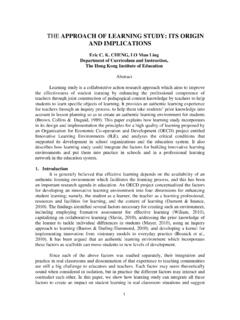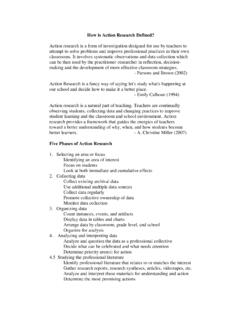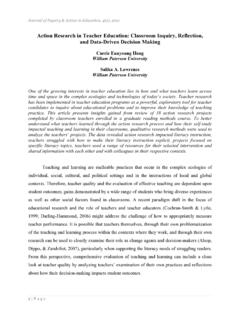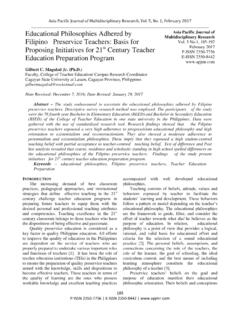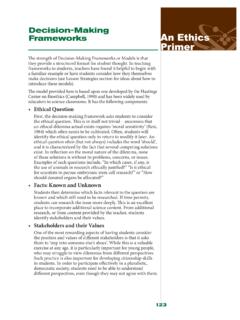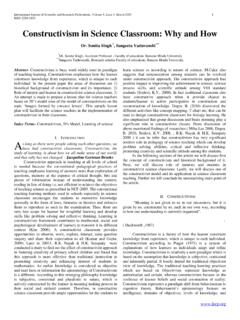Transcription of ACTION RESEARCH: AN APPROACH FOR THE TEACHERS …
1 The Turkish Online Journal of Educational Technology TOJET October 2008 ISSN: 1303-6521 volume 7 Issue 4 Article 5. ACTION research : AN APPROACH FOR THE TEACHERS IN HIGHER. EDUCATION. Yasmeen, G. Ghazala Yasmeen Dept. of Physiology, University of Karachi. Karachi 75270, 0092-021-9261300-5 EXT 3458. ABSTRACT. Introduction: ACTION research is a formative study of progress commonly practiced by TEACHERS in schools. Basically an ACTION research is a spiral process that includes problem investigation, taking ACTION & fact-finding about the result of ACTION . It enables a teacher to adopt/craft most appropriate strategy within its own teaching environment. Objective: The objective of present work is to study the effectiveness & advantage of ACTION research at higher education level. Bio-Statistics taken as difficult, dry & non-interesting subjects by most of the biological sciences students was selected for the study. Methodology: Practical ACTION research (one of its mode) was chosen as a scheme of study to address the major problems of these students.
2 Beginning the cycle of ACTION research , students views were collected & main problem areas was identified. Within our educational environment, solutions (Actions) were implicated & results were evaluated periodically. Each time modifications were made by symmetrical communication to students without any attempt to direct the outcome of deliberate process. Results: The students' response in form of behavior & class room assessments showed a positive change in their interest & understanding of the subject. Conclusion: The study concluded that at all educational levels, ACTION research can be adopted to improve the teaching/learning outcomes & should also be practiced by university TEACHERS as important educational strategy. Key Words: Formative Study, ACTION research , Practical ACTION research INTRODUCTION. Historical Background: The origins of ACTION research (AR) are unclear in the literature but generally Kurt Lewin is considered the father' of AR (Kemmis & McTaggert, 1990; Zuber-Skerrit, 1992 & Holter & Schwartz- Barcott, 1993), who first coined the term, in his paper about Minority Problems (Kurt, 1946).
3 Its function in educational system began with the Science in Education Movement of late nineteenth century in which scientific method was applied to education (Masters, 1995) followed by the UK originated teacher -Researcher Movement advocating that all teaching should be based upon research (McKernan, 1991). By the mid 1970s, it was discussed as a separate field of research and four major types were reported including: 1) Traditional: that was applied WITHIN organizations in the areas of Organization Development, Quality of Working Life (QWL), Socio-technical systems ( , Information Systems), and Organizational Democracy. This traditional APPROACH tends toward the conservative, generally maintaining the status quo with regards to organizational power structures. 2) Contextual: that encompasses relations BETWEEN organizations. It stresses that participants act as project designers and co-researchers. The concept of organizational ecology and the use of search conferences come out of contextual ACTION research .
4 3) Radical: it has a strong focus on emancipation and the overcoming of power imbalances. 4) Educational Traditional ACTION research : A fourth stream, that of Educational ACTION research , has its foundations in the writings of John Dewey, the great American educational philosopher of the 1920s and 30s, who believed that professional educators should become involved in community problem-solving. Its practitioners, not surprisingly, operate mainly out of educational institutions, and focus on development of curriculum, professional development, and applying learning in a social context. It is often the case that university-based ACTION researchers work with primary and secondary school TEACHERS and students on community projects (O'Brien, 2001). Initially AR was limited to school settings and practiced by TEACHERS to observe the effect of any teaching strategy modification on focused students or to incorporate progressive changes in the syllabus taking all stakeholders but owing to its flexibility and more practical APPROACH , now it has been experimented at all levels of professional & formal education.
5 Basic Concept: ACTION to contribute both to the practical concerns of people in an immediate problematic situation and to further the goals of social science simultaneously. Thus, there is a dual commitment in ACTION research to study a system and concurrently to collaborate with members of the system in changing it in what is together regarded as a desirable direction. Accomplishing this twin goal requires the active collaboration of researcher and client, and thus it stresses the importance of co-learning as a primary aspect of the research process (Thomas et. al., 1986) AR is a formative study of progress that is simply Learning by Doing . Scientifically, it can be described as a systematic inquiry that is collective, collaborative, self-reflective and The Turkish Online Journal of Educational Technology TOJET October 2008 ISSN: 1303-6521 volume 7 Issue 4 Article 5. undertaken by participants (students, teacher , colleagues or any other stakeholder) in an educational situation in order to improve the rationality of their own educational practices, as well as their understanding of these practices and the situations in which theses practices are carried out, with an aim to contribute to the practical concerns of immediate problematic state, being limited in available resources in accordance with typical classroom circumstances (modified from McCutcheon & Jurg, 1990; Kemmis & McTaggert, 1990 & Rapoport, 1970).
6 Core Components: There are many ways in which AR can be practiced in a particular setting. It is a cyclical process that never ends but always provides a conclusion with more ideas to bring upon progress and improvement. Whatever the settings and participants are, usually it has been carried out into four consecutive phases. shows a simple model of the cyclical nature of the typical AR process, each cycle has four steps: Plan, Act, Observe, Reflect (Dan, 1995). Figure 1: Simple ACTION research Model (from Dan MacIsaac, 1995). Gerald Susman (1983) gives a somewhat more elaborate listing. He distinguishes five phases to be conducted within each research cycle (Fig. 2). The Turkish Online Journal of Educational Technology TOJET October 2008 ISSN: 1303-6521 volume 7 Issue 4 Article 5. DIAGNOSING. Indentfying or defining a problem ACTION . SPECIFYING PLANNING. LEARNING. Considering Indentifying general alternative courses findings of ACTION EVALUATING TAKING ACTION .
7 Studying the Selecting a course consequences of an of ACTION ACTION Figure 2: Detailed ACTION research Model (Adapted From Gerald Susman, 1983). Initially, a problem is identified. This is followed by a collective postulation of several possible solutions, from which a single plan of ACTION emerges and is implemented. Data on the results of the intervention are collected and analyzed, and the findings are interpreted in light of how successful the ACTION has been. At this point, the problem is re-assessed and the process begins another cycle. This process continues until the problem is resolved. (Gerald, 1983 & McKay, 1992). Principles: What gives ACTION research its unique position is the set of principles that guide the research . Richard (1989) provides a comprehensive general overview of six key principles. These can be considered in any of the educational settings. 1) Reflexive critique: An account of a situation, such as notes, transcripts or official documents, will make implicit claims to be authoritative, , it implies that it is factual and true.
8 The principle of reflective critique ensures people reflect on issues and processes and make explicit the interpretations, biases, assumptions and concerns upon which judgments are made. In this way, practical accounts can give rise to theoretical considerations. 2) Dialectical critique: Reality is consensually validated, which is to say it is shared through language. Phenomena are conceptualized in dialogue; therefore a dialectical critique is required to understand the set of relationships both between the phenomenon and its context, and between the elements constituting the phenomenon. The key elements to focus attention on are those constituent elements that are unstable, or in opposition to one another. These are the ones that are most likely to create changes. 3) Collaborative Resource: Participants in an ACTION research project are co-researchers. The principle of collaborative resource presupposes that each person's ideas are equally significant as potential resources for creating interpretive categories of analysis, negotiated among the participants.
9 4) Risk: The change process potentially threatens all previously established ways of doing things, thus creating fears among the practitioners. One of the more prominent fears comes from the risk to ego stemming from open discussion of one's interpretations, ideas, and judgments. Initiators of ACTION research will use this principle to allay others' fears and invite participation by pointing out that they, too, will be subject to the same process, and that whatever the outcome, learning will take place. 5) Plural Structure: The nature of the research embodies a multiplicity of views, commentaries and critiques, leading to multiple possible actions and interpretations. This means that there will be many accounts made explicit, with commentaries on their contradictions, and a range of options for ACTION presented. A report, therefore, acts as a support for ongoing discussion among collaborators, rather than a final conclusion of fact. The Turkish Online Journal of Educational Technology TOJET October 2008 ISSN: 1303-6521 volume 7 Issue 4 Article 5.
10 6) Theory, Practice, and Transformation: For ACTION researchers, theory informs practice, practice refines theory, in a continuous transformation. In any setting, people's actions are based on implicitly held assumptions, theories and hypotheses, and with every observed result, theoretical knowledge is enhanced. The ensuing practical applications that follow are subjected to further analysis, in a transformative cycle that continuously alternates emphasis between theory and practice. Classification: In literature, many researchers have discussed different types of AR. Kemmis & McTaggert (1988) describe it as Technical, Practical (participatory) & Emancipatory. Holter & Schwartz-Barcott (1993) also explain three types: Technical collaborative, Mutual collaborative & enhancement APPROACH . While McKernan (1991) also list three modes of AR: Scientific - technical, Practical deliberative & Critical emancipatory. Emily (1993) describes three other modes: teacher researcher, Collaborative research & School-wide ACTION research .










